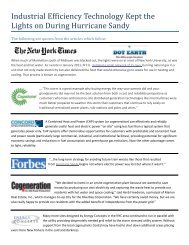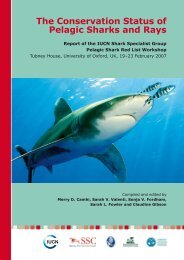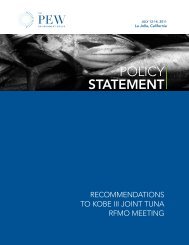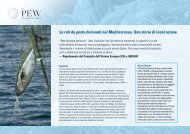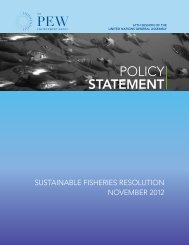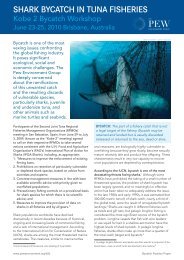The Law That's Saving American Fisheries - Ocean Conservancy
The Law That's Saving American Fisheries - Ocean Conservancy
The Law That's Saving American Fisheries - Ocean Conservancy
You also want an ePaper? Increase the reach of your titles
YUMPU automatically turns print PDFs into web optimized ePapers that Google loves.
limits in all U.S. fisheries and enforcing those limits through<br />
accountability measures. 13<br />
<strong>The</strong> Magnuson-Stevens Fishery Conservation and<br />
Management Reauthorization Act of 2006 built on those<br />
reforms and strengthened them by adopting key recommendations<br />
of the Pew <strong>Ocean</strong>s Commission and the U.S.<br />
Commission on <strong>Ocean</strong> Policy. <strong>The</strong> reforms require councils to<br />
specify annual catch limits and accountability measures, and<br />
require scientific advisers to make fishing-level recommendations<br />
that serve as the upper limit on the annual catch.<br />
Ending overfishing is important not only to preserve<br />
species, populations, and marine ecosystems but also to<br />
preserve future opportunities for fishing communities<br />
to maintain their livelihoods. <strong>The</strong> economic benefit of<br />
commercial fishing for coastal communities is well-known,<br />
but the effect of recreational fishing on these communities<br />
has become increasingly important in economic value,<br />
number of participants, and level of landings. 14<br />
Ensuring the sustainability of this public resource is<br />
critical for recreation and food. Allowing U.S. fisheries to<br />
realize their potential while avoiding overfishing yields<br />
value in revenue, exports, jobs, recreation, and other<br />
economic activity.<br />
Of the 245 species whose overfished status<br />
was reported as “known” in the 2000 edition of<br />
the NOAA <strong>Fisheries</strong> Service’s Status of Stocks,<br />
92 of them, or 38 percent, were classified<br />
as overfished (at a level unable to support<br />
maximum sustainable yield). Similarly, 72 stocks,<br />
or 26 percent, of 282 reported as known were<br />
experiencing overfishing in 2000. By the time<br />
the Magnuson-Stevens Act was reauthorized in<br />
2006, 25 percent of the known reported stocks<br />
were still overfished, and 20 percent were still<br />
experiencing overfishing.<br />
Ending overfishing represents the fulfillment of the vision<br />
of 1976. In the words of Sen. Stevens in 2003: “Senator<br />
Magnuson and I, when we first introduced this bill, agreed<br />
on one goal: This bill was not a bill to protect fishermen;<br />
it was not a bill to protect jurisdiction of states; it was<br />
to protect the reproductive capacity of our fisheries.<br />
And I think that should continue to be the goal as<br />
we go forward.”<br />
1,000<br />
Status of U.S. fish stocks, 1997-2012<br />
100%<br />
Number of stocks reported to Congress<br />
800<br />
600<br />
400<br />
200<br />
0<br />
1997<br />
1998<br />
1999<br />
2000<br />
2001<br />
2002<br />
2003<br />
2004<br />
2005<br />
2006<br />
2007<br />
2008<br />
2009<br />
2010<br />
2011<br />
2012<br />
90%<br />
80%<br />
70%<br />
60%<br />
50%<br />
40%<br />
30%<br />
20%<br />
10%<br />
0%<br />
% Stocks experiencing overfishing % Stocks overfished<br />
<strong>The</strong> <strong>The</strong> <strong>Law</strong> <strong>Law</strong> That’s That’s <strong>Saving</strong> <strong>Saving</strong> <strong>American</strong> <strong>Fisheries</strong>: <strong>Fisheries</strong>: <strong>The</strong> <strong>The</strong> Magnuson-Stevens Fishery Fishery Conservation and and Management Act Act 13<br />
13



